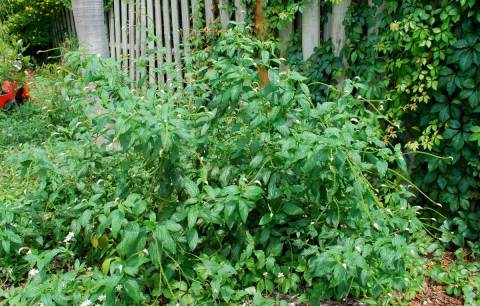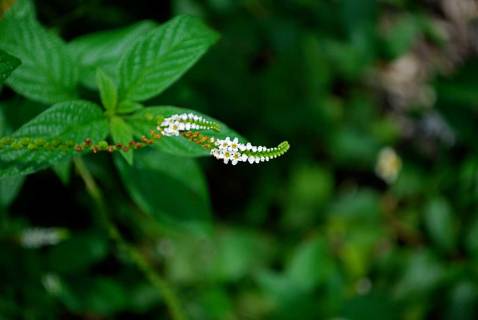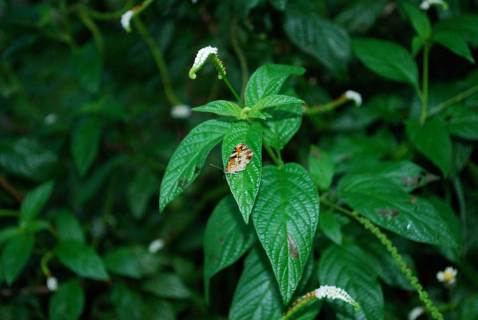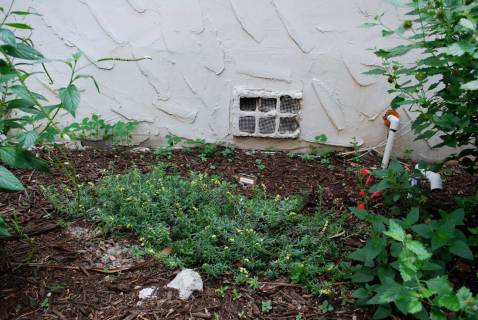Heliotropium angiospermum, aka Scorpion’s-Tail, is one of the prettiest and most interesting little plants I’ve seen in south Florida. I wrote it up back in May, but it’s such a nifty little plant that I thought I’d bear the risk of repeating myself. The strongly veined and sculptured leaves remind me of wild coffee (Psychotria nervosa), but the flowers are much more conspicuous and showy. I seem to have hit upon the perfect sunny location for it in my backyard, because here’s what the plant looked like a couple of months ago, only 6 weeks or so after planting:
And that’s pretty small compared to what it looks like these days:
The uniquely shaped inflorescence (actually a long double row of tiny flowers) is what gives the plant its common name; its forked shape brings to mind the tail of a scorpion:
These multiple and numerous flowers attract several species of butterfly for the nectar, among them the lovely Pearl Crescent (Phyciodes tharos):
The genus name, Heliotropium, is a bit of a misnomer; this plant does not turn its leaves or flowers to maintain alignment with the sun like young sunflowers (Helianthus species, which also look a bit like the sun, hence sun-flower). Instead, it’s named for the curving nature of the flowers, that are supposed to look as though they curve to follow the sun, but they really point every which way as you can see from the photos.
According to the Indian River Research and Education Center’s page on this plant, it is one of 4 heliotropes native to Florida: “All have a woody base and are characterized by tiny flowers borne in a row along only one side of a flower stalk. (H. curssavicum-seaside succulent leaves, H. amplexicaule-purple flowers, H. polyphyllum-white to yellow flowers).”
The plant does get a bit weedy, though. Just check out the difference between the May photo (first one above) and the one I took today (second photo above). Rufino Osorio recommends “severe annual pruning to maintain a tidy appearance”; I have to agree with him.
This is also a relatively short-lived plant that needs to be replaced completely every 3 years or so. Replacement is not supposed to be a problem because it does tend to generate self-sown seedlings in the vicinity of the parent plant. I’ll be on the lookout for them; they’ll be the ones that look like baby wild coffee, but without any parent plants nearby.
In fact, this giant “weed” in my back yard was a hitchhiker in a pot that was supposed to contain just a red stopper seedling. I noticed that the pot also had what looked like a baby wild coffee, but I didn’t bother to separate them, because even coffee doesn’t grow super duper quickly (much more quickly than the stoppers, though).
But Scorpion’s-Tail, being a short-lived plant, has to grow pretty quickly. And with quick growth comes quick senescence as well. Once this flowering plant wears out I’ll probably just let the stopper take over the site; that one is growing fine in the shade cast by the heliotrope.
I have another one of these guys in the front “courtyard,” which I’m trying to turn into a butterfly garden. It’s situated right next to its congener, H. polyphullum, Pineland heliotrope, and another weedy shrub with many small flowers, Cordia globosa:
I realize now that I’ve made a mistake in their arrangement, since the tiny pineland heliotrope (only a few inches tall at most) is planted behind the taller scorpions-tail. Oh, well. From such mistakes is experience gained.
Here you can see a shot of the little yellow guy:
I suppose you’ve never made a mistake in the garden?







I bought scorpion tail heliotropes in the very southern tip of Texas about 15 years ago to plant in my Houston native garden. They lasted about 3 years, then withered away. No Houston nursery has ever had them, nor have I ever seen any in any other Houston native collector’s gardens. I know one nursery in Austin had them in the past. I considered replacing them, but never made a trip to either long distant source.
Then this year, in early summer, one sprouted in my garden. Now 4 more have come up, possibly from new seeds of that first volunteer. I’ll try to take better care and will collect seeds, this time.